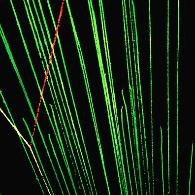Two particle scattering
Classically, if we wish to consider a collection of identical particles, say billiard balls, it is always possible to label all the balls such that we can follow a single ball throughout interacting with others. It is not, however, possible to attach such labels to a quantum mechanical systems of, say, electrons. Quantum mechanical particles are far to small to attach such physical labels and there are not enough degrees of freedom to label each particle differently. Again considering the classical case, one could imagine simply recording the position of a given particle throughout its trajectory to distinguish it from any other particle. Quantum mechanically, however, we again fail in following a single particles trajectory since each time we make a measurement of position we disturb the system of particles in some uncontrollable fashion. If the wave functions of the particles overlap at all, then the hope of following a single particles trajectory is lost. We now attempt to study the consequences of such indistinguishably between identical quantum particles.
Scattering of Identical Particles
Let's look at the case of two identical bosons (spin 0) from their center of mass frame. To describe the system, we must use a symmetrized wave function. Under the exchange , is invariant while changes sign. So the center of mass wave function is already symmetric. Furthermore, the wave function has even parity. This implies that the only possible eigenstates of angular momentum of the two particles are those with even angular momentum quantum numbers. This is evident from the property of the associated Legendre polynomials.
But we have to symmetrize by hand:
Under the transformation:
The first two terms of the symmetrized wave function represent the incident waves corresponding to the center of mass frame. Note that because we are considering identical particles we cannot distinguish the target particle from the incident one. Thus, each particle has equal amplitude of being either one.
The scattering amplitude is:
and can then be associated with the angle through which each particle is scattered. The total amplitude for particles to emerge at each angle is then exactly the sum of amplitudes for emerging at each angle, which is given above. The scattering amplitude remains consistent with the fact that we have two identical particles, and this gives us the differential cross section:
Note:
The first two terms in the differential cross section is what we would get if we had two distinguishable particles, while the third term give the quantum mechanical interference that goes along with identical particles.
As an example, consider scattering through a 90 degree angle. We then have:
Now if the particles are distinguishable, the cross section for observing a scattered particle at 90 degrees is then:
Where if the particles are indistinguishable, we see above that we will have:
Thus the differential cross-section is exactly twice the distinguishable case when the particles are indistinguishable.












![{\displaystyle {\frac {d\sigma }{d\Omega }}=|f(\theta ,\phi )+f(\pi -\theta ,\phi +\pi )|^{2}=|f(\theta ,\phi )|^{2}+|f(\pi -\theta ,\phi +\pi )|^{2}+2\Re e[f(\theta ,\phi )f^{*}(\pi -\theta ,\phi +\pi )]}](https://wikimedia.org/api/rest_v1/media/math/render/svg/d8972b9bd40cd5e046bc3e3e9960fccb9157665f)


